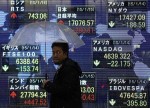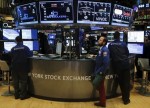
- All Instrument Types
- Indices
- Equities
- ETFs
- Funds
- Commodities
- Currencies
- Crypto
- Bonds
- Certificates
Please try another search

U.S. Q2 GDP Revised Upward: ETFs In Focus

Economic growth in the United States was stronger than initially expected by the markets. Per the Commerce Department, economic growth was 3% in second-quarter 2017 compared with its earlier estimate of 2.6%.
This was the best GDP growth since first-quarter 2015. Better-than-expected increase in consumer spending and business investment drove the GDP growth.
Business investment increased at 0.6% in Q2 compared with the earlier estimate of 0.4%. Moreover, the United States labor market added 237,000 jobs in August compared with 201,000 in July.
Consumer spending played a major role in the upward revision. It grew 3.3% in Q2 compared with the government’s earlier estimate of 1.9%. Moreover, consumer confidence in the United States increased to 122.9 from 120 in July, and above market estimates of 120.7. Also, a gauge of consumer expectations increased to 104 from 103.
This is representative of strong confidence in people with regard to their future financial condition and willingness to spend more. Given that personal consumption accounts for almost 70% of GDP, this number is indicative of optimism.
This data point is special because President Donald Trump has promised to take the economic growth figure to 3% annually by cutting down on regulations, introducing his tax reform policy, boosting infrastructure spending and other major legislations.
Moreover, for a president battered by controversy and experiencing nose-diving approval ratings, this is a good sign. Although there is speculation around developments being made in the tax reform plan by Trump’s administration, his Charlottesville comments, where he stated that both sides were to blame in the protests, was a negative for his approval rating.
However, we cannot assume that the growth rate will persist. The IMF foresees challenges to productivity and economic growth in the United States given a large number of baby boomers and saturation in the labor market.
The United States equity markets have also been going through tough times. U.S. equity funds have witnessed outflows of $30 billion since late June through August 23, 2017, per a Bank of America (NYSE:BAC) report citing EPFR Global data. Funds saw investors pulling out $2.6 billion in the 10th consecutive week, the longest stretch since 2004 (read: U.S. Equities See Record Outflows: ETFs in Focus).
The primary reason for these outflows is being attributed to the rising political uncertainty in the United States and growing doubt over if President Donald Trump will be able to implement his pro-growth policies (read: What's in Store for the U.S. Treasury Bond ETFs?).
Let us now discuss a few ETFs focused on providing exposure to U.S. equities.
SPDR S&P 500 ETF (NYSE:SPY) (AX:SPY)
This fund is the most popular ETF traded in the U.S. markets. It seeks to provide exposure to the largest and most stable companies and tracks the S&P 500 index.
It has AUM of $243.35 billion and charges a fee of 9 basis points a year. From a sector look, the fund has high exposures to Information Technology, Health Care and Financials with 23.38%, 14.46% and 14.31% allocation, respectively (as of August 29, 2017). The fund’s top three holdings are Apple Inc (NASDAQ:AAPL) , Microsoft Corporation (NASDAQ:MSFT) and Facebook Inc (NASDAQ:FB) with 4.05%, 2.69% and 1.89% allocation, respectively (as of August 29, 2017). The fund has returned 12.89% in the last one year and 10.10% year to date (as of August 30, 2017). It currently has a Zacks ETF Rank #3 (Hold) with a Medium risk outlook (read: U.S. Producer Prices Down: ETFs in Focus).
iShares Core S&P 500 ETF IVV
This fund is a low-cost ETF that seeks to provide exposure to the large established U.S. companies and tracks the S&P 500 index.
It has AUM of $122.38 billion and charges a fee of 4 basis points a year. From a sector look, the fund has high exposures to Information Technology, Health Care and Financials with 23.29%, 14.42% and 14.26% allocation, respectively (as of August 29, 2017). The fund’s top three holdings are Apple Inc, Microsoft Corporation and Facebook Inc with 4.04%, 2.68% and 1.89% allocation, respectively (as of August 29, 2017). The fund has returned 13% in the last one year and 10.12% year to date (as of August 30, 2017). It currently has a Zacks ETF Rank #2 (Buy) with a Medium risk outlook (read: The S&P Will Double Within the Next 5 Years).
PowerShares QQQ ETF QQQ
This fund is a popular ETF that maintains a hefty exposure to U.S. tech companies and tracks the Nasdaq 100 index.
It has AUM of $51.85 billion and charges a fee of 20 basis points a year. From a sector look, the fund has high exposures to Information Technology, Consumer Discretionary and Health Care with 59.02%, 21.52% and 11.19% allocation, respectively (as of August 29, 2017). The fund’s top three holdings are Apple Inc, Microsoft Corporation, and Amazon.com Inc (NASDAQ:AMZN) with 12.65%, 8.40% and 6.79% allocation, respectively (as of August 29, 2017). The fund has returned 24.25% in the last one year and 22.24% year to date (as of August 30, 2017). It currently has a Zacks ETF Rank #2 with a Medium risk outlook.
Bottom Line
Although this is a positive step in the direction, it cannot be said with certainty that Trump will be able to achieve what he desires. This is primarily because his targets are extraordinary and it is a herculean task for a developed economy to achieve 3% annual growth rate. However, it is not impossible and despite increased pessimism with regard to Trump’s ability on delivering his promises, it is still too early to come to a conclusion.
Want key ETF info delivered straight to your inbox?
Zacks’ free Fund Newsletter will brief you on top news and analysis, as well as top-performing ETFs, each week. Get it free >>
Amazon.com, Inc. (AMZN): Free Stock Analysis Report
Facebook, Inc. (FB): Free Stock Analysis Report
Apple Inc. (AAPL): Free Stock Analysis Report
Microsoft Corporation (MSFT): Free Stock Analysis Report
NASDAQ-100 SHRS (QQQ): ETF Research Reports
SPDR-SP 500 TR (SPY): ETF Research Reports
ISHARS-SP500 (IVV): ETF Research Reports
Original post
Zacks Investment Research
Related Articles

Tesla (NASDAQ:TSLA) (NYSE: TSLA), the electric vehicle giant, has recently experienced a significant drop in its stock value, which has fallen nearly 45% since December. This...

Through many years of frustration among gold bugs due to the failure of gold stock prices to leverage the gold prices in a positive way, there were very clear reasons for that...

I know there is the smell of fear in the air when I see my readership double as we reach a point where weekly chart factors come into play. Up until last week, markets have...
Are you sure you want to block %USER_NAME%?
By doing so, you and %USER_NAME% will not be able to see any of each other's Investing.com's posts.
%USER_NAME% was successfully added to your Block List
Since you’ve just unblocked this person, you must wait 48 hours before renewing the block.
I feel that this comment is:
Thank You!
Your report has been sent to our moderators for review





Add a Comment
We encourage you to use comments to engage with other users, share your perspective and ask questions of authors and each other. However, in order to maintain the high level of discourse we’ve all come to value and expect, please keep the following criteria in mind:
Enrich the conversation, don’t trash it.
Stay focused and on track. Only post material that’s relevant to the topic being discussed.
Be respectful. Even negative opinions can be framed positively and diplomatically. Avoid profanity, slander or personal attacks directed at an author or another user. Racism, sexism and other forms of discrimination will not be tolerated.
Perpetrators of spam or abuse will be deleted from the site and prohibited from future registration at Investing.com’s discretion.